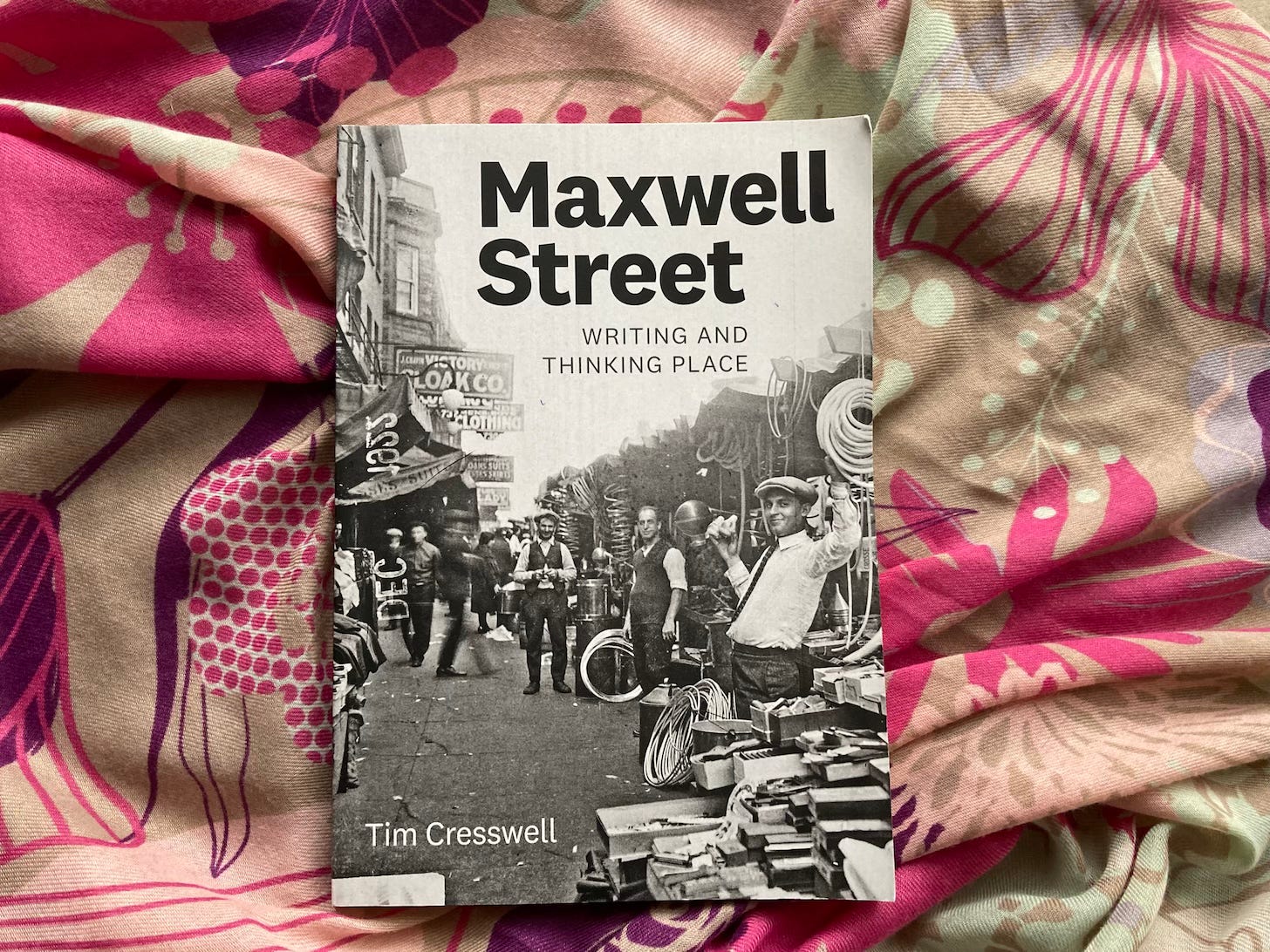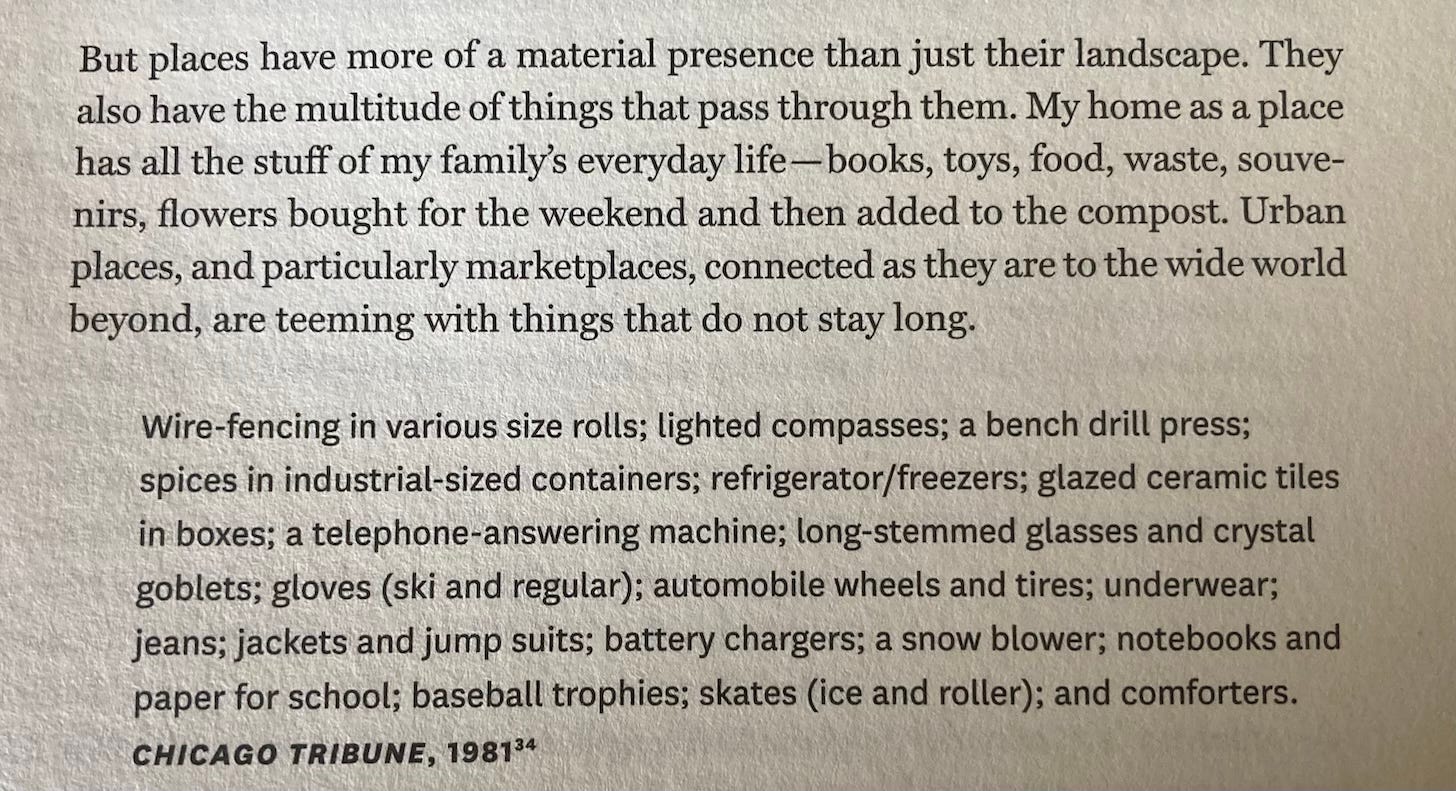In this Substack we celebrate the art and craft of Place Writing. Do you want to be inspired? Join our band of readers and writers who love everything about place and home. Subscribe now and get fortnightly posts delivered to your in-box for free.
Maxwell Street was published in 2019, and it’s rather special because the author consciously describes it as a work of Place Writing; I think geographer and theorist Tim Cresswell is the first to make such a statement within the text of a book.
The author’s focus is on an area that has changed dramatically in recent times. For over a century this specific location in Chicago housed a market; people gathered and made deals on anything from a loaf of bread to a pair of shoes, from a bird cage to a second-hand bicycle, from a car hubcap to a long-handled broom.
‘From the plaques you would learn that this was the site of North America’s largest open-air market. You would learn that in the early twentieth century it was one of the most densely populated areas in the United States, a place where immigrants from Europe and migrants from the east and south of the nation settled, a place of cosmopolitan poverty.’ (p21)
The old Maxwell Street lives on in Cresswell’s rendering of place, in the sights and sounds of trading, in the odours of sweat and decaying vegetables, and in the soulful music-making. Cresswell got to know the area well over many years and he captures the spirit of place through his experience and research. He records every aspect of Maxwell Street and its environs; he covers its geography, its history, and its people.
After reading the book a few times, I believe that the bustling neighbourhood that used to exist can be reimagined if only you know where to stop and look.
Why is it Place Writing?
Cresswell proceeds to explain his method of Place Writing by dividing the book into three sections: Writing Place; Market/Place; and Thinking Place. The central section is very much about Maxwell Street whilst the other two sections are about Place Writing. According to Cresswell, his practice, method, or process, is one of ‘assemblage’. I understand this to be like collage where the author knits together pieces of text and images with his own prose to make interesting pages for the reader to peruse and linger over. With personal commentary and photographs, and excerpts from newspapers, fiction, poetry, non-fiction… the fragments are carefully curated.
This book is not well known because it is written as an academic text and, as far as I know, it’s not been promoted to a wider readership (thus, it only has a pinky toe in the commercial world). I hope that, by bringing your attention to it, you might want to get hold of a copy and maybe use it as a blue print for your next piece of Place Writing. Or perhaps you might consider assemblage in terms of visual art and gather text and other materials to produce a piece of work that communicates the essence of a place you know well.
What is your process? Tell me about your current place project… I look forward to chatting with you in the comments!
Reference, credits, and links:
Cresswell, T. (2019) Maxwell Street. University of Chicago Press.
The photos are of my own copy of Maxwell Street, purchased by me. The image of the Hardware shop with shoe stall in foreground was taken by Russell Lee in 1941. The excerpt about ‘material presence’ is from page 199.
If you would like to buy Maxwell Street and support independent bookstores, you can do so via my Bookshop account.
This post is one of a series—see my page Recommended Books. To my knowledge, no shelves exist in libraries or bookshops labelled ‘Place Writing’ and these books in my opinion are good examples of the genre. I see it as my mission to create more awareness of Place Writing. I hope that one day books like these will gain recognition as epitomising the genre and officially be categorised as such.
Tim Cresswell writes Place Matters on Substack.







The place where I always write is at my little wooden desk sitting on my non-ergonomic chair.
However, when it comes to streets, I think my favourite is High Street, in Nelson, BC, Canada, where I used to live.
There are so many wonderful things about it. In this hilly town, it's one of the few streets that runs adjacent to downtown, so hills can be avoided between home and town. It's also beautiful, with many different kinds of trees lining it. And there are people of mixed incomes, so is non-homogenous. There's even a house that is shaped like a boat with gargoyle on top of it.
It's the preferred walking route from Fairview to downtown, so it's a great place to run into people.
I used to look up from my desk out my front window and see who was walking by on High Street, and I miss that view.
Wonderful, Yasmin. I want to get my hands on this book! Well, both of them.
I use place a lot in my writing. I also draw on Benjamin's Arcades Projects in my thoughts about this, even though I'm talking about my fiction writing. Thanks for sharing with us.